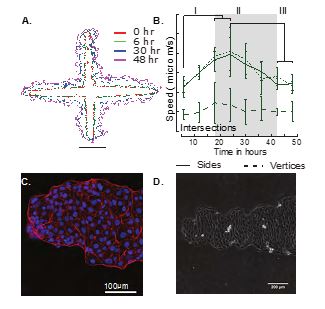Tissue Biomechanics
Aortic aneurysms Arteries continually undergo cyclic expansion and contraction to fulfil varying hemodynamic demands. Fibrotic arterial diseases are associated with elastic fiber degradation, collagen deposition, and their subsequent cross-linking, which results in higher tissue stiffness and extracellular matrix remodelling. Thoracic aortic aneurysms (TAA), and those leading to dissections (TAD), are associated with a significant risk of mortality, morbidity, and emergency surgeries. We worked with clinicians in Narayana Hrudayalaya, Bangalore and tested arterial tissues from patients undergoing replacement surgery. See our work in J. Biomech. Engg. that adds emphasis to growth and remodeling in arteries. In collaboration with Prof. Jaywant Arakeri (ME, IISc), we investigated the differences in flows through highly curved tubes with curvatures similar to the aorta. This work, published in J. Fluid Mechanics, was completed by two jointly supervised M.Tech. students, Mr. Ashlin Augusty and Mr. Vamsi Krishna. We showed radially inward moving secondary flows that have the structure of wall jets on the straight walls; their subsequent collision on the inner wall leads to a radially outward moving jet. We demonstrated that the flow separation on the inner wall, reported in several previous studies, has origins in the secondary flows and not the axial pressure gradient proposed earlier. We also used patient specific geometries of the ascending aorta (AA) and the internal carotid artery (ICA), with and without aneurysms, and quantified the flow physics in these vastly different geometries using computational fluid dynamics. Our work (J. Biomechanics, 2020) shows comparisons in various flow metrics, such as time averaged wall shear stress (TAWSS), oscillatory shear index (OSI), and transWSS, at these locations. We propose a novel graphical representation of WSS using shear rosettes to map temporal changes in the flow dynamics during a cardiac cycle at any spatial location on the vessel surface. We also define a new metric, anisotropy ratio, using the shear rosette which is useful to describe the uni-directional and bi-directional effects of flows.

Mechanics of rubber-like materials
We investigated the uniaxial and biaxial mechanical properties of Poly (dimethyl siloxane) (PDMS; Sylgard® 184, Dow Corning, USA) prepared using different amounts of crosslinkers to produce materials with variable physical entanglements and chemical crosslinks (Experimental Mechanics, 2014). We showed that the Edward-Vilgis slip-link model, based on separation of the individual contributions of chemical crosslinks and physical entanglements, is better at describing the stress-strain responses of highly crosslinked networks at low stretches as compared to other constitutive models. We also investigated the role of crosslinks, entanglements and sol fractions in the mechanical properties of PDMS prepared with different ratios of base to crosslinker (Materials Research Express, 2018). Check out our paper for details.
Mechanics of bioinspired materials
Bioinspired, tailored, fiber reinforced elastomers (FRE) for soft robotic applications exploit the ability to change their overall shape and material stiffness under loads. We fabricated FRE materials in transversely isotropic layouts varying from 0-90° using a custom filament winding technique and characterized the nonlinear stress-strain relationships using uniaxial and equibiaxial experiments. This is useful in magic angles in musculo-hydrostats. Our work in Soft Robotics (2020) describes these relationships. Vivek Sharma is using this setup to next quantify the mechanics of skin wrinkling in materials with transversely isotropic symmetries.
Hydrogel Mechanics
The development and characterization of porous scaffolds for tissue engineering and regenerative medicine is of great importance. Variable polymer concentration, fluid-saturated two phases, large deformation properties, and the relatively brittle fracture make hydrogels fascinating and challenging. We have quantified the hydraulic permeability of silk-based hydrogels using confined compression and long-term creep experiments, fabricated special nonlinear conducting properties using PEDOT:PSS and PVA, and characteirzed the viscoelastic properties of gelatin-methacrylate gels (GelMA) in tissue engineering. Anshul Shrivastava is continuing this work to quantify the fracture properties of hydrogels — stay tuned!
Cell Mechanobiology
We are broadly interested in cell-substrate interactions during adhesions and migrations. Our work on cell tractions is now available as free download (upon request) for regularized-FTTC method for single cell tractions. Neha Paddillaya and Aritra Chatterjee are working on quantifying tractions in cells under fluid shear and cyclic stretch. They presented this at the Biophysical Society meeting in San Diego (2020). We are also interested in quantifying the adhsions using a stochastic finite element model through work by Siddhartha Jaddivada now posted as a preprint article. Siddhartha is also demonstrating the role of talin unfolding dynamics in his thesis using this model. This work is in collaboration with Prof. Martin Schwartz (Yale). Aritra has also developed a new microscope mountable biaxial stretcher to watch cell adhesions under cyclic stretch. He shows the mechanistic basis for re-orientation responses of fibroblasts under cyclic uniaxial stretch using a growth and remodeling framework (under review). The role of collective cell migrations and monolayer viscoelasticity are new projects we hope to quantify using this device.

Biomaterials and Biomimetics
Many insects forage, oviposit or inject venom in their prey by penetrating or cutting through substrates. Insects use diverse mechanisms with relative ease to puncture, fracture, and steer probes within substrates. Insect probes used for cutting and steering are especially interesting because they combine the functional aspects of hardness at the tool tip to facilitate cutting, and yet must be sufficiently flexible to steer and gain access to specific regions within the substrate without undergoing fracture. We show that the cutting parts of insects, such as mandibles or ovipositor tips, are often zinc-enriched and hardened as compared to the other cuticular regions (JMBBM, 2020). Whereas tip hardening is key to their ability to penetrate surfaces, it is often also important for probes to be manoeuvrable through substrates. How do insect probes negotiate the trade-off between cutting and steering through substrates of diverse stiffness (J. Experimental Biol, 2014)? These are fascinating questions that are of much interest to our laboratory.
